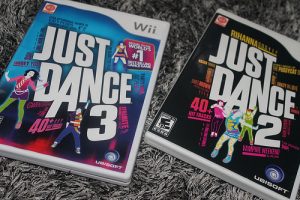Though Just Dance doesn’t claim to be a workout game, for some, it’s the workout that keeps them coming back for more.
Making fitness entertaining is vastly underrated. You won’t need motivation when you associate exercise with having a good time.
The question is, can Just Dance provide you with a cardio workout that’s worthy of your time? Let’s look deeper into that.
The Golden Age of Fitness Games
When Wii came out in 2006, gamers were given the impression most games would involve considerable physical activity.
In time it became clear that waggle-ware, requiring subtle wrist and arm movements, vastly outnumbered games of the more strenuous variety.
Although a slew of fitness games came out for the Wii during its peak and later for the Xbox 360 Kinect, most fell short of expectations. Although software that tracks your movements sounded good on paper, implementation often left something to be desired.
With any Wii game, you can cheat the system and play as lazily as possible while still achieving objectives and high scores. Thus, you need to be self-motivated to get a good workout. Kinect titles made strides to correct this since it tracks the position of your entire body.
What this period did right is it gave working out entertainment value and interactivity. With so many forms of amusing distractions out there that lock you onto the couch, games that make you sweat provide a counterbalance.
Just Dance as a Fitness Game Alternative
 During the seventh-generation console era, plenty of fitness games were available. Those looking for an enhanced workout gravitated towards titles like EA Sports Active, Wii Fit Plus, Your Shape Fitness Evolved, and Zumba Fitness.
During the seventh-generation console era, plenty of fitness games were available. Those looking for an enhanced workout gravitated towards titles like EA Sports Active, Wii Fit Plus, Your Shape Fitness Evolved, and Zumba Fitness.
Dance titles that offer a cardio workout like Just Dance and Dance Dance Revolution were often overlooked for those with fitness goals in mind. Today, with fewer fitness games on the market, Just Dance has become a more and more prominent option.
Due to the astronomical popularity of Just Dance, publisher Ubisoft has consistently been pumping out sequels and spinoffs. Each release boasts the hottest new tracks. So, it makes sense that it has continued to stay relevant.
For the fitness crowd, Just Dance 2 was the first sequel with “just sweat” mode. It allows players to measure the energy they expend as well as set fitness objectives to be met during their dance sessions.

Why Just Dance?
While Just Dance doesn’t offer the sophisticated fitness components you’d expect from an exergame, the fun factor, choreography, stunning visuals, and great music more than make up for it.
There are reports online of people losing substantial weight purely with Just Dance so clearly features like weight tracking, calendar features, etc. aren’t as significant as motivators as we’ve been led to believe. It’s way more important that the game is fun, intuitive, and free of technical frustrations.
You’re unlikely to quit during a song, and there are so many routines to master. Thus, Just Dances incentivizes gamers to keep going. Before you know it, quick play sessions turn into full cardio workouts.


One great aspect of Just Dance is there is always a new version coming out with new tracks so it stays fresh. With a game like EA Sports Active for example the music is generic, however you can turn it off and play your own MP3s with another device. Granted this is an apples-to-oranges comparison, but it’s a factor to consider when assessing the replay value of the Just Dance series.
Another advantage it offers over fitness games is it’s fun to play with a group. While exercise carries the connotation of work and strain with it, dancing does not. Your friends might even be the ones who will con you into getting off your rump and popping it in.
Conclusion
Overall, you’d be crazy not to try it even if you’re not big on bubblegum pop. Think of it as a guilty pleasure or claim it’s “for the kids” if need be.
